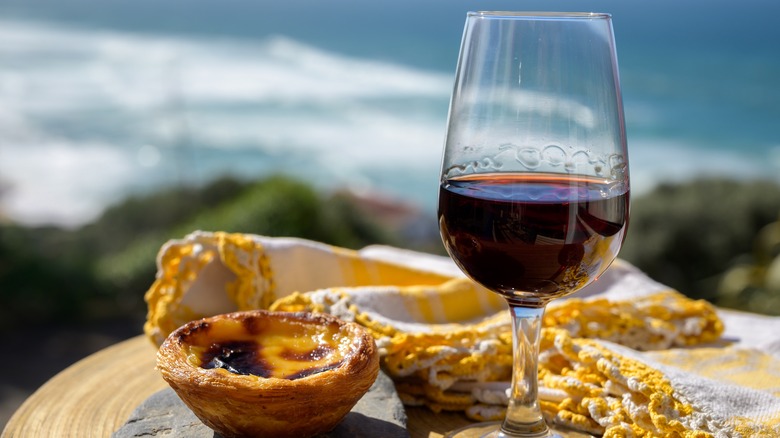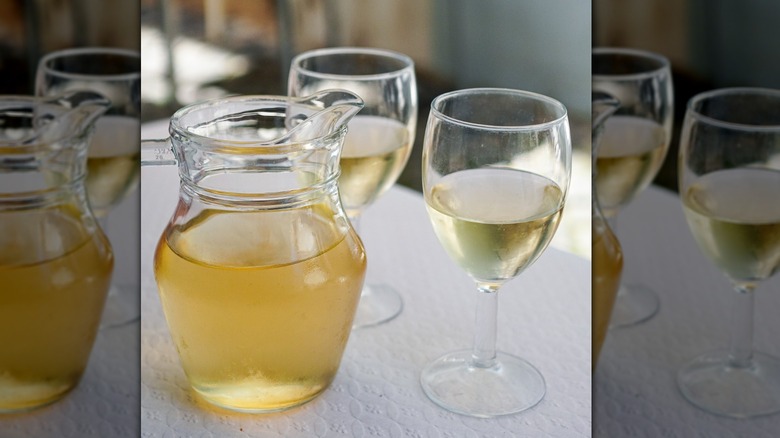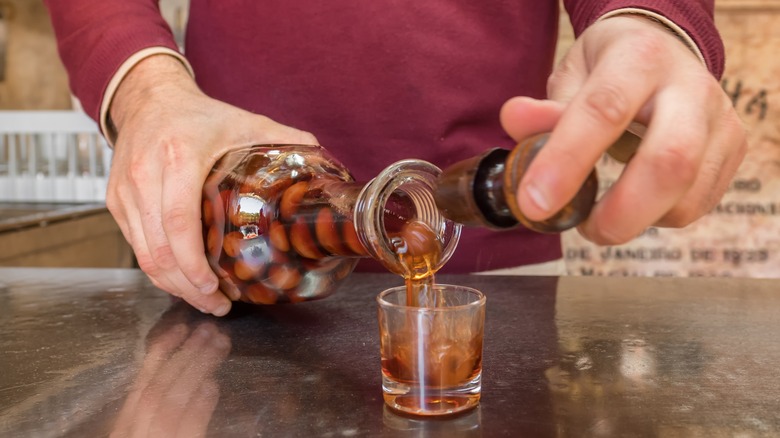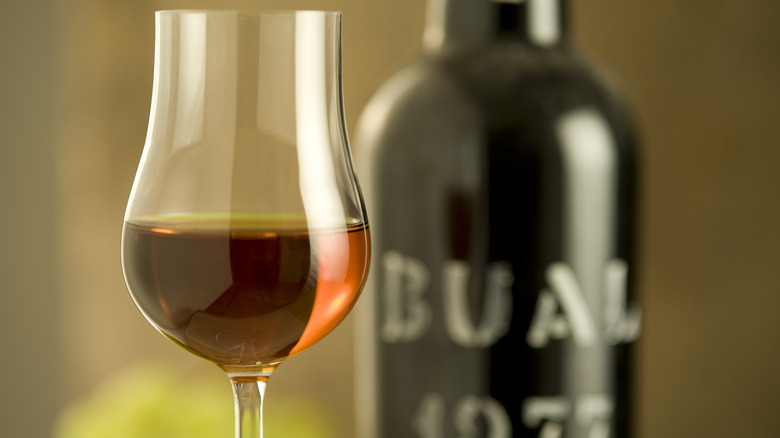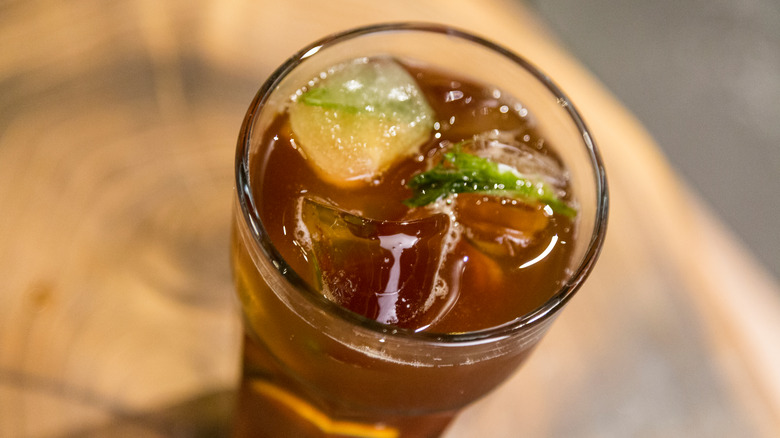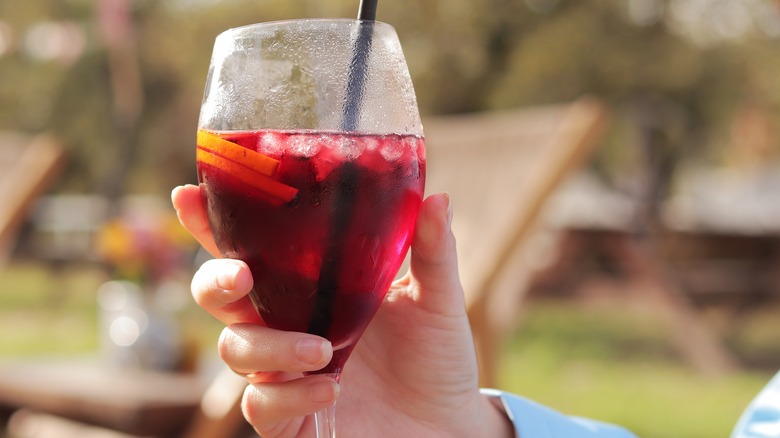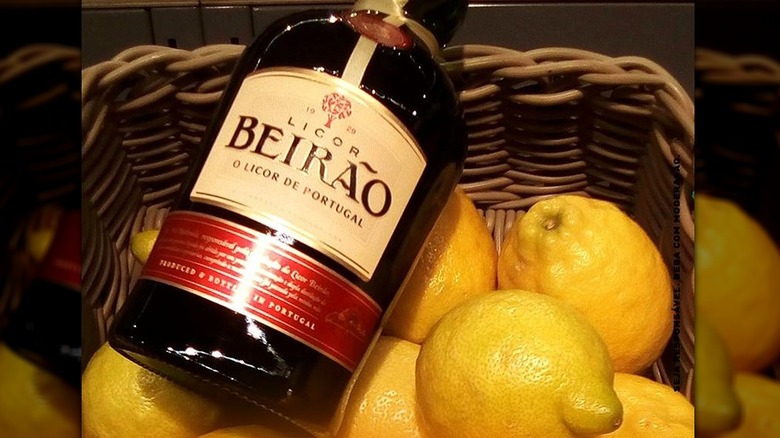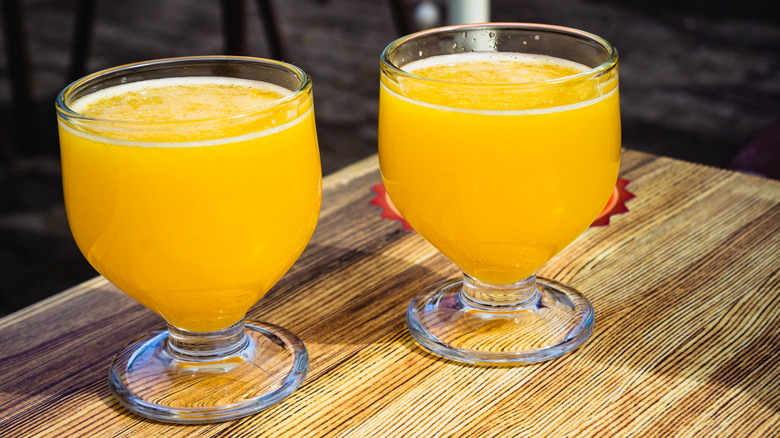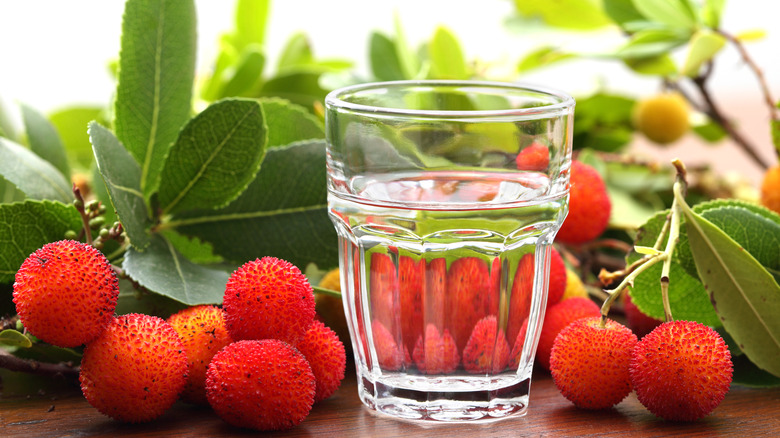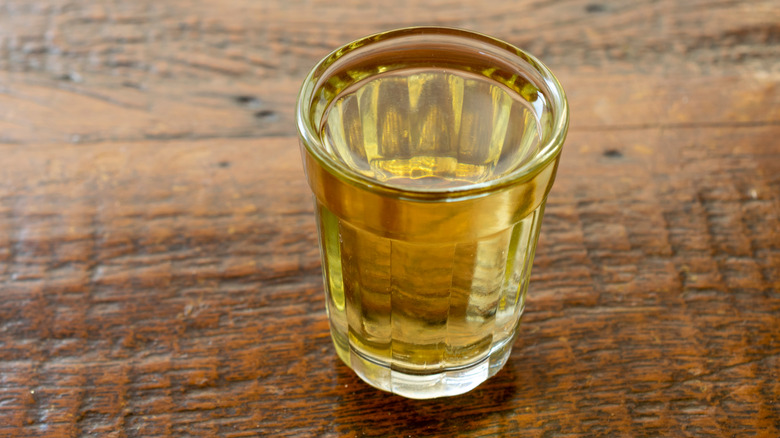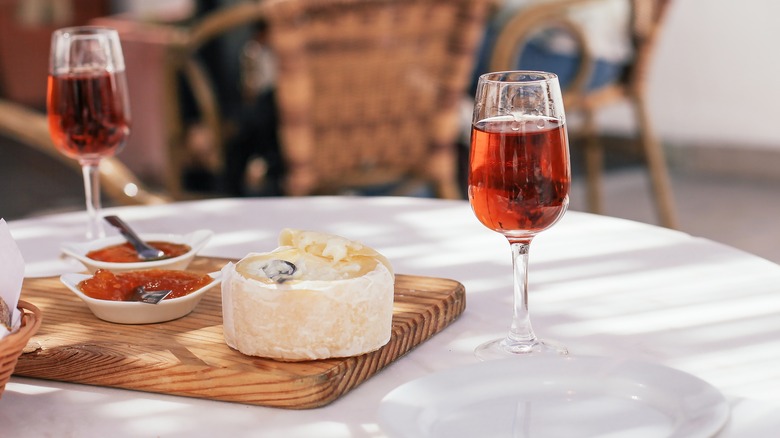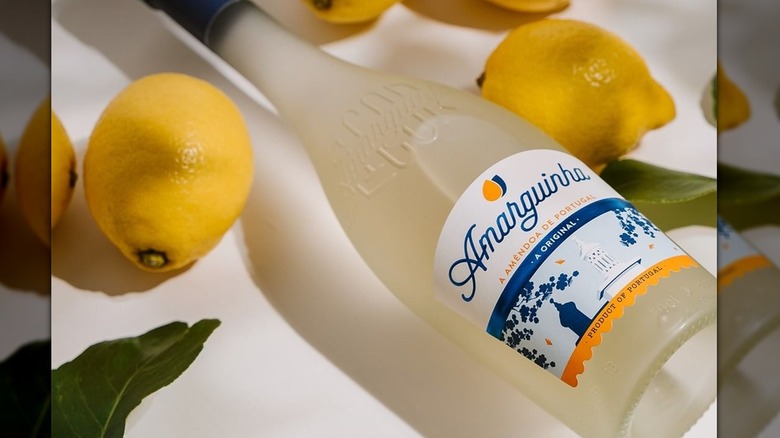12 Portuguese Drinks You Should Try At Least Once
Whether you're wandering through cramped alleyways in Lisbon, exploring the lush vineyards of the Douro Valley, or catching some rays in the Algarve, Portugal is a small country with lots to offer. In addition to its charming town centers, pleasant climate, and friendly locals, Portugal is known for its food. Seafood, egg tarts, and duck rice are just a few dishes to sample in this Iberian nation.
But exploration of Portuguese culture is only complete with a sip of its diverse array of drinks. From distinctive wines like Vinho Verde and Port to unexpected liqueurs like sour cherry ginjinha and bitter almond Amarguinha, you'll never be bored (or thirsty) in Portugal. Besides its alcoholic offerings, Portugal also serves up mazagran, a lemonade iced coffee, and capilé, a refreshing summer drink made from maidenhair leaves and orange blossom. Follow along as we explore these drinks and more. By the end, you'll know exactly what to order the next time you find yourself in a Portuguese restaurant.
1. Vinho Verde
Portuguese wines don't receive the same recognition as their French or Spanish counterparts, and that's a shame. Portugal boasts 13 wine regions and is the 11th largest wine producer in the world. That's pretty impressive considering the country is roughly the size of Indiana. Portugal has dozens of native grape varietals including Tinta Roriz, Alvarinho, and Maria Gomes. These are all worth exploring, but if you're after something uniquely Portuguese, don't miss out on Vinho Verde.
Translated as "green wine," Vinho Verde might sound like a radioactive elixir, but it's not green at all. Rather, the name refers to its youthful character, not its color. Most varieties are white, however, red and rosé versions also exist. In terms of taste, young Vinho Verdes are known for their lively fizz, crisp acidity, and relatively low alcohol content of 8% to 12%. These distinctive characteristics come from the terroir of the Minho Province in northwestern Portugal. Bordered by the Atlantic Ocean, mountains, and rivers, this region provides an ideal environment for wine production. In terms of pairing, Vinho Verde complements seafood dishes and light summertime fare like salads and grilled chicken.
2. Ginjinha
Also known as ginja, ginjinha is a sweet liqueur made by soaking tart Morello cherries in aguardente, a distilled fruit spirit. After a few months of steeping, sugar and cinnamon are added to create its unique flavor. The result is a tangy yet sweet liquor boasting an alcohol content between 18% and 24%. Ginjinha's origins are shrouded in mystery. Some say it was invented by a friar at Lisbon's Igreja de Santo António in the 15th or 16th century, while others suggest it emerged in the 19th century. Nonetheless, given the Morello cherry's European roots and medicinal use in Portugal dating back to the 1500s, its transformation into a liqueur was a natural progression, regardless of who did it first.
If you want to try ginjinha in Portugal, head to one of Lisbon's ginja bars for an authentic local experience. These places are small and cozy, usually accommodating only a few customers at a time. Before you order, decide if you want your shot with cherries ("com elas") or without ("sem elas"). Most locals prefer it with cherries, but beware — they pack a tart punch! Depending on where you go, you might also have the option of drinking your shot out of a chocolate cup for an added layer of decadence.
3. Port wine
If you're acquainted with just one quintessential Portuguese drink, it's likely Port wine. Originating from the Douro Valley in northern Portugal, Port is a sweet, fortified wine distinguished by the addition of unaged brandy before fermentation. Adding brandy helps retain the grapes' natural sweetness, resulting in a drink with a round, velvety character, and an alcohol content of around 20%. Port is crafted from a blend of native Portuguese grapes such as Touriga Franca, Touriga Nacional, and Tinta Roriz.
While the name Port is shared, there are several diverse styles. Ruby Port is fruity, youthful, and vibrant, while Tawny Port has a nutty profile complemented by notes of caramel and dried fruit. Vintage Ports are made with grapes from a single exceptional year. They undergo a minimum two-year aging process and evolve in the bottle for decades. Late Bottled Vintage Ports also originate from single-year grapes, however, they're aged longer before bottling than Vintage Ports, meaning they can be enjoyed sooner. Lastly, there's white port, which can be either dry or sweet, making it an excellent aperitif or cocktail addition.
4. Mazagran
Portuguese coffee drinks don't have the same status as those from Italy. Despite their lesser-known status, they offer a range of options and exceptional quality. Alongside classics like espressos and lattes, Portugal boasts a few unique caffeinated creations, one of which is mazagran, an iced coffee drink infused with lemon. Although widely appreciated in Portugal, this drink actually originates from Mazagran, Algeria.
French troops stationed in Mazagran in the mid-1800s created the first version of the drink out of necessity. Finding themselves without milk or brandy, the troops resorted to adding water to their morning cups. It was pretty tasty, so they took it home to Paris. There, it became a popular drink between the Belle Époque and World War II. Over time, cafés started adding ice and a side of lemon to the drink.
Although the drink's popularity waned in post-war France, mazagran found new life in nearby Portugal. Once installed on the Iberian Peninsula, it underwent more modifications, including the addition of sweetened lemon or lime juice. Some variations even incorporate mint leaves or cachaça, a Brazilian distilled spirit. No matter how you serve it, a mazagran is the perfect thirst-quenching beverage for Portugal's sweltering summers.
5. Sangria
Given its global presence and influence in the culinary world, it's easy to associate sangria solely with Spain. However, this beloved summertime libation's origins are intertwined with Spanish and Portuguese history. Dating back to around 200 B.C., sangria's roots can be traced to the Romans who conquered the Iberian Peninsula, fostering a shared cultural legacy between the two nations. Moreover, a 2014 European Union law dictates that only sangria produced in Spain and Portugal can rightfully bear the name.
Despite the rigid definitions, Portuguese sangria recipes offer plenty of flexibility. While red wine serves as the classic base, variations featuring white (branco), rosé, or even sparkling (espumante) wine are readily available. Portuguese brandy and a splash of Port contribute depth, while seasonal fruits such as lemons, limes, and apples add zest and sweetness. Some cinnamon sticks and mint leaves provide the finishing touch, creating a perfect day-end drink.
6. Licor Beirão
Licor Beirão's slogan is "O licor de Portugal" (the liqueur of Portugal). It's a boastful claim, but it's not without merit. Not only does Beirão hold the unofficial title of Portugal's national drink, but you'll find this herbal liqueur in just about every café, bar, and restaurant in Portugal, something that further solidifies its status. Its versatility knows no bounds, as it's enjoyed neat, in cocktails, blended with coffee, and even infused into ice cream.
The enigmatic flavor profile of Licor Beirão is a closely guarded family secret, but it's known to contain botanicals and spices like eucalyptus, cinnamon, rosemary, lavender, aniseed, and mint. With an alcohol content of 22%, it offers a smoother and sweeter taste compared to other herbal liqueurs like Jägermeister and Chartreuse.
Originating in the 19th century in Lousã, a town in north-central Portugal, Licor Beirão was initially formulated as a stomach medication by a pharmacist. As regulations shifted and the sale of alcoholic tinctures was outlawed, the pharmacist's son-in-law transformed it into a beverage. Years later, it achieved acclaim by winning a gold medal at a competition in Beirã, a nearby town. The drink was rechristened Beirão in honor of the region, and the rest is history.
7. Poncha
Located 669 miles southwest of mainland Portugal, Madeira comprises a cluster of volcanic islands renowned for their breathtaking beauty. But to label them as merely beautiful would be an understatement. The diverse landscape of lush forests, rugged coastlines, and mesmerizing waterfalls is nothing short of awe-inspiring. Beyond its geographical wonders, the islands boast a rich culinary heritage. From scabbard filet and limpets to bolo do caco, a round flatbread, Madeira offers a gastronomic adventure like no other.
Complementing these dishes is poncha, a native cocktail with a fascinating history. Originally created by fishermen as an elixir to soothe sea-sprayed throats, poncha remains a beloved tradition. Its timeless recipe features sugar cane brandy (aka Maderian rum), sugar, and lemon juice, blended with a stick called a caralhinho. Despite its innocent appearance resembling juice, poncha packs a punch, boasting an alcohol content ranging from 40% to 60%. Your best bet is to sip slowly and eat plenty of lupini beans, the traditional pairing for this heady cocktail.
8. Capilé
If you're unfamiliar with capilé, you're not alone. This cordial syrup made from natural ingredients like maidenhair leaves and orange blossoms remains relatively unknown, even among Portuguese locals. Part of its obscurity can be attributed to its age. Indeed, the recipe appeared in "Modern Cook," a Portuguese cookbook published in 1780.
Adding to this is the fact that capilé isn't widely consumed in Portugal. You'll have no trouble finding the other drinks on this list, but tracking down capilé requires a bit of a scavenger hunt. In Lisbon, you might stumble upon it in a few select spots. One option is at a kiosk, aka the gazebo-like outdoor cafés scattered in parks and squares across the city. Another possibility is Manteigaria, a renowned pastel de nata maker with multiple locations throughout Lisbon. Though it may take some effort to find, the subtly floral and delicately sweet flavor of capilé is well worth the search.
9. Medronho
Pretty much every country in Europe has its own potent, fruit-based spirits. Rakia, a double-distilled brandy crafted from local fruits, reigns supreme in the Balkans. Greece presents ouzo, a unique grape must-derived liquor infused with anise flavor. Meanwhile, Italy contributes grappa, a liquor distilled from the grape remnants of winemaking. Portugal proudly joins this tradition with medronho, a fiery spirit derived from medronho berries.
These berries, which resemble a cross between strawberries and lychees, have a vibrant red-orange hue and thrive in Portugal's Alentejo and Algarve regions. Despite the abundance of the fruit, the number of legal producers is relatively low. With that said, local authorities often turn a blind eye to keep the tradition alive. Due to the informal nature of medronho production, you're not likely to find it in supermarkets. Rather, your best bet is to venture into rural areas and look out for local signage. If you do manage to get your hands on some, savor it in true Portuguese fashion — after dinner as a digestif or alongside the morning's first espresso.
10. Aguardente
Translated as "fire water," aguardente is essentially a distilled brandy. Some varieties are made using grape pomace, a substance comprised of leftover grape skins, seeds, and stems from winemaking. Neutral white wines high in acidity are most commonly used, however, aguardente can also be made from fruits like apples, pears, or figs. After distillation, the unaged version, known as aguardente bagaceira, is bottled. At this stage of the process, the aged variety, referred to as aguardente com caixa or bagaço, matures in oak barrels for periods ranging from two years to multiple decades.
While aguardente is often enjoyed neat, it's also frequently used to fortify Port wines. The aged version is also commonly added to coffee to create café com cheirinho, aka "coffee with a little scent." Similarly, it can be used to make brandy cocktails like Sidecars or B&Bs. Meanwhile, the unaged variety makes an excellent addition to cocktails like the Metropolitan and Vieux Carre.
11. Moscatel
Exploring grape varieties can be tricky, especially when names are similar. Consider Muscat and Muscadet: at first glance, they might seem like variations of the same name, but they actually represent vastly different wines. Muscat, originating from the Mediterranean, is a white grape known for producing sweet wines. In contrast, Muscadet is a dry wine from France's Loire Valley, made with the Melon de Bourgogne grape.
Portugal's Moscatel falls into the sweet category. Among the main types of Moscatel found in Portugal, Moscatel de Setúbal (internationally known as Muscat of Alexandria) and Moscatel Galego Branco (Muscat Blanc à Petits Grains) from the Douro region are notable. These wines are unique not just because of their terroir, but also because they're fortified with grape brandy. This addition makes for a deeper flavor profile distinguished by notes of marmalade, flowers, and grapes. It also increases the alcohol percentage to somewhere between 16% and 22%. The Portuguese typically drink it as an aperitif or with chocolatey desserts.
12. Amarguinha
Located on Portugal's southernmost coast, the Algarve region is celebrated for its stunning cliff-backed beaches, charming hand-painted tiles, and mouthwatering seafood. Amidst its many attractions, one standout gem is Amarguinha, a liqueur made from bitter almonds. It's one of Portugal's most cherished traditional liqueurs and the modern recipe is a reflection of age-old local traditions. Reminiscent of Italian amarettos, it boasts a delightful sweetness on the palate, with a fragrant aroma of marzipan and cream, and a subtle yellow hue.
With an alcohol content of 20%, Amarguinha is incredibly versatile, serving as both an aperitif and a digestif. Its most iconic presentation involves pouring it over ice cubes and adding freshly squeezed lemon juice. This simple combination balances the liqueur's sweetness with the tartness of the lemon, resulting in a perfectly balanced libation. For even easier preparation, there's Amarguinha Limão, which has citrus flavor built in. Additionally, the company produces Amarguinha Creme, a rich and creamy variation with a hint of bitterness.
